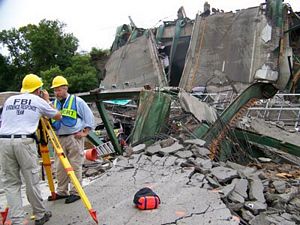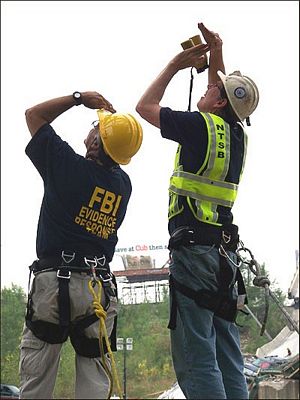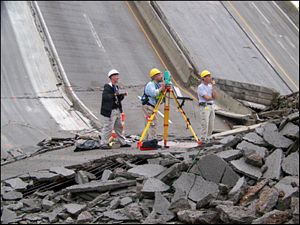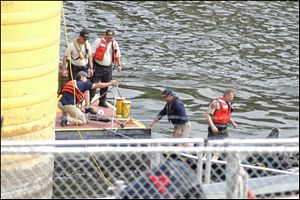|
By accessing or using The Crittenden Automotive Library™/CarsAndRacingStuff.com, you signify your agreement with the Terms of Use on our Legal Information page. Our Privacy Policy is also available there. |

Ready to Help
|
|---|
|
|
Ready to Help
Federal Bureau of Investigation
August 17, 2007
 FBI Evidence Response Team members record damage to the I-35W bridge, which collapsed August 1 in Minneapolis. ERT members from the Minneapolis field office, as well as FBI offices in San Antonio, Pittsburgh, and Chicago, aided the federal probe, led by the National Transportation Safety Board. FBI Evidence Response Team members record damage to the I-35W bridge, which collapsed August 1 in Minneapolis. ERT members from the Minneapolis field office, as well as FBI offices in San Antonio, Pittsburgh, and Chicago, aided the federal probe, led by the National Transportation Safety Board.
 An FBI ERT member aand NTSB official survey the damage at the collapsed bridge site. An FBI ERT member aand NTSB official survey the damage at the collapsed bridge site.
 FBI evidence technicians survey the scene. FBI evidence technicians survey the scene.
 FBI USERT members work with Hennepin County sheriffs in preparing to lower radial sonar equipment into the Mississippi River. FBI USERT members work with Hennepin County sheriffs in preparing to lower radial sonar equipment into the Mississippi River.
|
Our Role in Bridge Collapse Probe
Minneapolis Special Agent Chris O’Leary was packing up to head home and chatting on the phone when his friend on the line relayed the surreal news playing out on television—the I-35W bridge had just collapsed into the Mississippi River. Instinct kicked in. Trained “in an earlier life” as an emergency medical technician, O’Leary checked in with his bosses and then drove to the disaster site to help any way he could.
“Typically when you get into this type of situation, people look to you as an FBI agent for guidance,” O’Leary said. “In this case I was asking the firefighters, ‘How can I help?’”
O’Leary’s response would come to symbolize the FBI’s role in the days that followed the August 1 rush-hour collapse of one of the city’s most traveled spans. Our initial role was to determine if there was a link to terrorism or criminal activity—agents interviewed victims and ran down leads, and bomb technicians and evidence response teams scoured the massive scene. Within 24 hours, signs pointed toward a likely structural failure and our role turned to supporting the Minneapolis authorities leading the emergency response and the National Transportation Safety Board (NTSB), the lead agency probing the eight-lane highway’s collapse.
To understand our continuing role in the bridge probe and recovery efforts even after terrorism links were discounted requires an understanding of how the FBI continually operates with partner agencies at the federal, state, and local levels. Long before the disaster, the FBI was already training with the Minneapolis Police Department and Hennepin County Sheriff’s Office in emergency response scenarios (next year’s Republican National Convention is in their jurisdiction).
A few more examples of local joint efforts include:
Twin Cities Security Partnership: a group formed by our Minneapolis office in 2003 to bring together leaders in law enforcement and private industry. Agency chiefs coordinating their roles at the bridge site already knew one another by name. Local industry responded within hours of the collapse with unsolicited donations of supplies and food for rescue and recovery workers.
Joint Terrorism Task Force: personnel from local law enforcement agencies staff the JTTF in our Minneapolis office, providing expertise and clear channels of communications.
Evidence Response Team: the unit, based at the FBI Academy in Virginia, includes agents stationed around the country, including Minneapolis, and trains continuously with NTSB investigators, most often on determining causes of plane crashes. The relationship was codified in a 1999 memorandum of understanding spelling out each agency’s roles—FBI leads criminal and terror cases, NTSB leads accident probes.
The result was a near seamless coordination of roles within the unified command post on the scene.
“It went remarkably well,” said Minneapolis Supervisory Special Agent E.K. Wilson, a crisis management coordinator and JTTF domestic terrorism supervisor. “Most of the people we’re working with down here we’ve already got relationships with and have worked with before.”
That kind of arrangement was key for Special Agent O’Leary, a member of the JTTF who has been in Minneapolis for four years. He was one of the first on the scene to tend to victims. It wasn’t a time to wrangle over roles, command chains, or territorial disputes. “I saw this as a rescue operation,” O’Leary said. “That was my concern from the beginning.”
In the coming days we’ll have stories about the specific supporting roles we played in the probe and recovery effort, including our Evidence Response and Special Project teams, and an interview with Minneapolis Assistant Special Agent in Charge Tim Gossfeld, who like many was on the bridge in the hours before it collapsed and recounts the FBI’s initial response as it unfolded.

















 Topics: Interstate Highway System
Topics: Interstate Highway System
